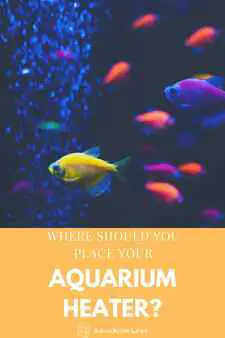If you’re new to aquariums, did you know that a quality heater is vital to your fish’s health and well-being? It’s an essential piece of equipment that keeps your fish happy and active. Without it, you risk disease and expensive resupplying, as well as the potential for an awkward conversation with your kids.
In this article, we’ll walk you through everything you need to know about fish tank heaters and provide tips on where best to place your new heater for maximum efficiency.
Aquarium Heater Size and Location Placement

Placement and heater size are two of the most critical considerations for aquariums. If you place the heater wrong, your fish can get trapped. If you get a heater that is too large or too small, your fish can overheat, or you risk stressing them and causing diseases.
Heater Placement
Place your heating unit near the maximum water flow where it has the best chance of distributing warm water through the fish tank. Your heater and your filters are the primary methods of heat circulation, so it’s best to place the heater near the outlet or inlet of the aquarium filter, which will help mix the heated water throughout the tank.
If you have a powerhead to mimic the water current, you can place the heater near it instead of the filter.
Keep in mind that different heaters have different recommendations and requirements. For instance, if you have a hanging heater, you want to make sure that there is space between it and the fish tank, or you risk trapping your fish.
Pay attention to the recommendations that come with your heater for the best results.
Heater Size
Most aquarium fish have strict requirements to maintain optimum health. If the water is too warm, you risk ‘cooking’ them. If the water is too cold, your fish have a higher risk of disease or dangerous stress. As cold-blooded animals, fish rely entirely on the water temperature to regulate their temperature, so proper heating is vital to their life.
To heat properly, think in terms of volume—estimate at least 5 watts per gallon of water. For instance, a 30-gallon tank would require 150 watts of heat. If you have a larger aquarium, like a 50-gallon, you can divide the heat into two units on either end. If you buy two heaters, make sure you have a good thermostat to keep aware of the temperature and check the heaters regularly for cracks or other issues.
Resource: Aquarium Heater Guide
How Heat Distribution Works in a Home Aquarium
Heat distribution is such a complex mechanism that it has its own branch of science – thermodynamics.
Without getting too deep into the mathematics of it, we can say that heat distribution throughout the aquarium is essential if you want to keep your fish healthy. This is why it’s vital to have a thermostat in your aquarium to help regulate the aquarium heater.
Essentially, warm water, like warm air, rises to the top of the tank while cooler water sinks. Also, your home generally has various heat cycles throughout the day, which can heat the water in the tank independently of the heater. To regulate these different natural actions, you need a thermostat that can trip the device, so it works with these processes.
If your thermostat or your heater is faulty or broken, it may lead to either a disruption of the heat transfer through the tank, making your fish too cold. Or, it could lead to the heater stuck permanently ‘on,’ leading to your fish cooking. Either option is devastating to your fish considering their delicate cold blood.
Heat Circulation
Heat circulates three different ways in an aquarium: convection, conduction, and circulation.
Convection is the most natural, but the least efficient, leading to poorly mixed layers of warm or cold water. Both conduction and circulation are natural processes but need a little help in the confines of a fish tank.
- Convection – Warm water rises and cold water sinks, creating a convection current.
- Conduction – Warm water warms up the molecules, which creates kinetic energy that disperses throughout the tank. Most standard heaters work on this principle.
- Circulation – The heater works directly with the filter to heat the water as it flows, which mixes the water thoroughly for a more even distribution of heat.
Choosing the Best Aquarium Heater
The best aquarium heaters aren’t the cheapest. If you want to maintain the health of your fish within the habitat without replacing them regularly, you may need to spend a little more than you think. The best type of heater and the aquarium heater’s output also depends on the kind of fish you keep.
Make sure you understand the type of fish you have and ask questions about their heat requirements. Knowing what sort of temperatures works with which fish is the first step to knowing which heater is best for your fish tank.
Remember that not all fish can live together due to their different temperature requirements – tropical fish generally require more heat, while goldfish have a larger range they can tolerate.
Look for a heater with an attached thermostat so you can monitor the temperature regularly. It can help regulate the temperature to avoid overheating the fish.
Here are the main types of aquarium heaters available:
- Immersible heater – Also known as a hanging heater. It has a classic heating design, including a glass tube with a heating unit inside. It usually hangs on the side of the tank.
- Submersible heater – Submersible heaters are entirely submerged and generally provide the best circulation. Make sure the fish have room to swim around it, and it doesn’t touch any tank decorations.
- In-line heater – These hook up to the filtration system, which helps them pump heated water evenly throughout the tank. Place it between the tank and the filter, but make sure your fish can’t get stuck.
- In-sump heater – This heater is similar to the in-line heater, but it saves space and doesn’t risk fish getting trapped. It inserts into the sump system.
With these tips for choosing and placing an aquarium heater, your fish should be happy, healthy and long-lived.

